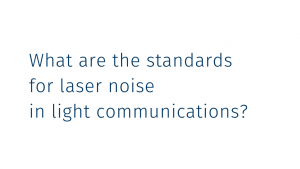Frequency Modulated Continuous Wave (FMCW) is an innovative method in modern radar and sensor technology. Its applications range from sensor systems in self-driving cars, to obstacle avoidance in aircraft and drones, to advanced signal detection and flight control in aircraft, and even LiDAR (light-based detection and ranging) systems. This article explains the basic principles of FMCW technology, how it differs from other ranging technologies, and specific examples of its use, and explores its potential.
Table of Contents
- What are the basic principles of FMCW technology?
- Importance of FMCW in Millimeter Wave Radar
- Application of FMCW in LiDAR Systems
- Challenges and Future Prospects of FMCW Technology
- Related News and Latest Technology Introduction
- Conclusion
- Feel free to contact us.
What are the basic principles of FMCW technology?
Definition and Mechanism of FMCW
FMCW (Frequency Modulated Continuous Wave) is a method of measuring distance using signals whose frequency changes with time. This technology compares the transmitted wave with the reflected wave from an object and analyzes the frequency and phase differences to calculate the distance and speed to the object.
Unlike the conventional pulse method, FMCW transmits signals continuously, allowing it to operate with low transmission power. In addition, since it analyzes the frequency variation of the reflected wave in detail, highly accurate distance and velocity measurements can be made. For this reason, FMCW radar performs particularly well in detecting moving objects. Furthermore, FMCW technology is not easily affected by weather or light conditions, enabling highly accurate detection at night or in bad weather. Mutual interference with other devices can also be avoided.
Because of these characteristics, FMCW is especially useful in advanced driver assistance systems (ADAS) for automobiles, radar systems for aircraft, and navigation for drones.

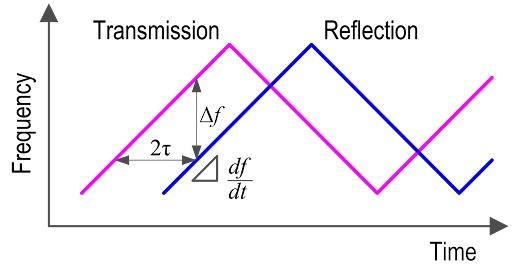
Differences from Pulse Radar: Methods and Applications
There are several important differences between FMCW technology and conventional pulse radar in terms of their methods and applications.
- Differences in Signal Methods
Pulse radar: A short-duration, high-power signal is transmitted intermittently and its reflected wave is detected. Because it uses high-power pulse signals, it is characterized by its ability to efficiently detect objects at long distances.
FMCW: Uses a continuous wave signal and simultaneously receives the reflected wave while transmitting the signal. It is characterized by easy miniaturization of the sensor, light weight, energy-saving performance, and cost efficiency. - Differences in Applications
Pulse radar: Suitable for fields that require large-scale, long-distance measurements, such as aviation, ship monitoring, and weather observation. Although it is difficult to reduce size and cost because of the need for a high-power transmitter, its advantage is its high reliability that enables accurate monitoring over a wide area. Especially in the defense field, it is widely used for early warning and target tracking due to its high detection capability.
FMCW: FMCW is especially beneficial in the automotive industry, where mass production is required. It reduces installation space constraints and allows more sensors to be installed in the vehicle. In self-driving vehicles, a large number of FMCW sensors are installed to improve the safety performance of the vehicle by providing a three-dimensional understanding of the surrounding environment.

Differences from Doppler Radar: Methods and Applications
The Doppler effect is a phenomenon in which a signal source such as sound or radio waves and its observation device each move, and when there is a difference in speed between the signal source and the observation device, the observation device measures a frequency with a value different from that of the sound or radio wave signal source. The frequency becomes higher when the distance is getting closer and lower when the distance is getting farther apart. Radars that apply this Doppler effect include Doppler radar and FMCW radar.
- Difference in Signal Methods
Doppler radar: Transmits a continuous or pulsed radio wave and calculates the relative velocity of an object by detecting the frequency change (Doppler shift) in the signal reflected from a moving object. It is not suitable for obtaining distance information and is specialized for measuring speed.
FMCW radar: Measures both the distance and velocity of an object simultaneously by transmitting radio waves whose frequency is continuously varied over time and analyzing the frequency difference (beat frequency) between the reflected wave and the Doppler-shifted reflected wave. It is suitable for high-precision measurement of short distances. - Differences in Applications
Doppler radar: Applications include speed measuring devices such as speed guns for traffic enforcement, weather radar for measuring rain and wind movement, and speed measurements of balls and players in sports.
FMCW radar: Applications include in-vehicle radar for obstacle detection and distance measurement for automated vehicles, industrial sensors for distance and speed measurement in industrial applications, and anti-collision and altitude measurement for drones.

Importance of FMCW in Millimeter Wave Radar
Millimeter wave technology maximizes its performance when combined with FMCW. Millimeter waves have a high frequency that allows for high resolution with small antennas, and FMCW uses this to instantly determine the distance, speed, and direction of a target object.
Applications in Automated Driving Vehicles
The combination of FMCW technology and millimeter-wave sensors is essential for the development of self-driving vehicles.
In particular, its highly accurate distance measurement capability is utilized in advanced driver assistance systems (ADAS) and radar sensors in automobiles. This technology combination allows vehicles to instantly measure distance, speed, and direction from obstacles, which is used for vehicle collision avoidance and lane keeping assist, greatly improving autonomous driving and safety features.
Applications in Aeronautics and Space
In aircraft, millimeter-wave FMCW sensors are used for collision avoidance and obstacle detection in the air. In space exploration, this technology is also used to assist in the landing of Mars rovers.
Application of FMCW in LiDAR Systems
LiDAR (Light Detection and Ranging) is a method that combines FMCW technology with laser light to achieve high-resolution 3D imaging.
- High-precision 3D mapping
FMCW LiDAR uses light frequency modulation of laser light to enable higher spatial resolution and finer distance measurement than millimeter wave. This allows automated vehicles and robots to recognize their environment in greater detail. In particular, the ability to simultaneously measure distance and speed over hundreds of meters, very low interference between LiDARs of any type, and low susceptibility to ambient light are significant advantages over other LiDAR technologies such as Time to Flight (ToF). - Expanding Industrial Applications
FMCW LiDAR is also used for topographical surveying and construction site monitoring. By utilizing the characteristics of light, it is less susceptible to environmental and other conditions and can be used in a wide range of applications.

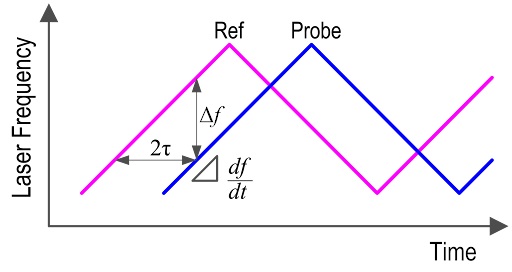
Challenges and Future Prospects of FMCW Technology
Technical Challenges Common to FMCW Systems
The main challenges of FMCW technology are complex signal processing and high cost. In particular, signal processing becomes more complex and requires advanced algorithms in order to achieve efficient real-time signal processing. Therefore, a high level of expertise is required to design and implement the system. In addition, there is a need for technological innovation to reduce the manufacturing cost of sensors, and research and development is still ongoing.
Technical Challenges of FMCW LiDAR
Light Frequency Modulation Characteristics of the laser beam are an important issue in FMCW LiDAR. Generally, frequency modulation with high linearity is required for FMCW systems; in FMCW LiDAR, the light frequency is modulated by changing the current that drives the laser diode, but transient temperature changes can cause loss of linearity in the light frequency modulation. Therefore, the Light Frequency Modulation Characteristics must be accurately evaluated. Since changing the laser diode current also changes the light intensity, a method that is unaffected by changes in light intensity is required in the evaluation of Light Frequency Modulation Characteristics.
In addition, since the light frequency noise of the laser diode affects the accuracy of FMCW LiDAR, a reduction of the light frequency noise is required.
In FMCW LiDAR, the light frequency noise within the modulation period of the laser light is the target of suppression. In general laser diodes, the light frequency noise in the frequency range lower than the modulation frequency band of FMCW LiDAR is larger. Therefore, it is necessary to evaluate the light frequency noise in the modulation frequency band of FMCW LiDAR, separating it from the light frequency noise in this lower frequency range.
FMCW LiDAR requires a two-dimensional scan of the laser beam emission direction, and this mechanism must be realized in a cost-effective manner. It is hoped that this can be achieved using light integrated circuit technology.
Future Research and Market Outlook
In the future, FMCW technology is expected to be integrated with AI, machine learning, and nanotechnology to enable even more accurate real-time analysis. In addition, research is being conducted on miniaturization and energy conservation, which is expected to further expand applications in the automotive, aerospace, and space development fields, as well as in the more familiar medical field.
Related News and Latest Technology Introduction
SYCATUS markets innovative products such as the A0070A Optical Frequency Analyzer, which evaluates Light Frequency Modulation Characteristics of FMCW LiDAR. This technology is boosting the application of FMCW technology in self-driving vehicles and aerospace.
In addition, at CIOE 2024 (China International Optoelectronics Expo) held in Shenzhen, China in September 2024, SYCATUS' A0070A Optical Frequency Analyzer and the A0010A RIN Measurement System and A0040A Optical Noise Analyzer, which evaluate laser noise, were exhibited.
Evaluating Light Frequency Modulation Characteristics: “A0070A Optical Frequency Analyzer”
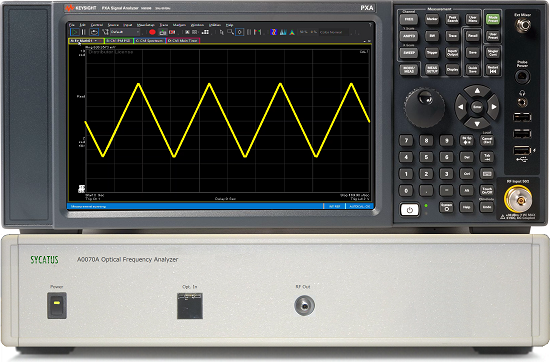
The A0070A Optical Frequency Analyzer is an innovative system dedicated to the evaluation of FMCW LiDAR lasers.
It enables real-time observation of light frequency modulation waveforms and extracts light frequency modulation components without the influence of light intensity modulation. No pre-measurement adjustments are required, the waveform is displayed immediately after laser input, and its high linearity enables accurate measurements even for wide light frequency deviations.
The A0070A facilitates the development and production of FMCW LiDAR.
Evaluating Laser Noise: “A0040A Optical Noise Analyzer” and “A0010A RIN Measurement System”
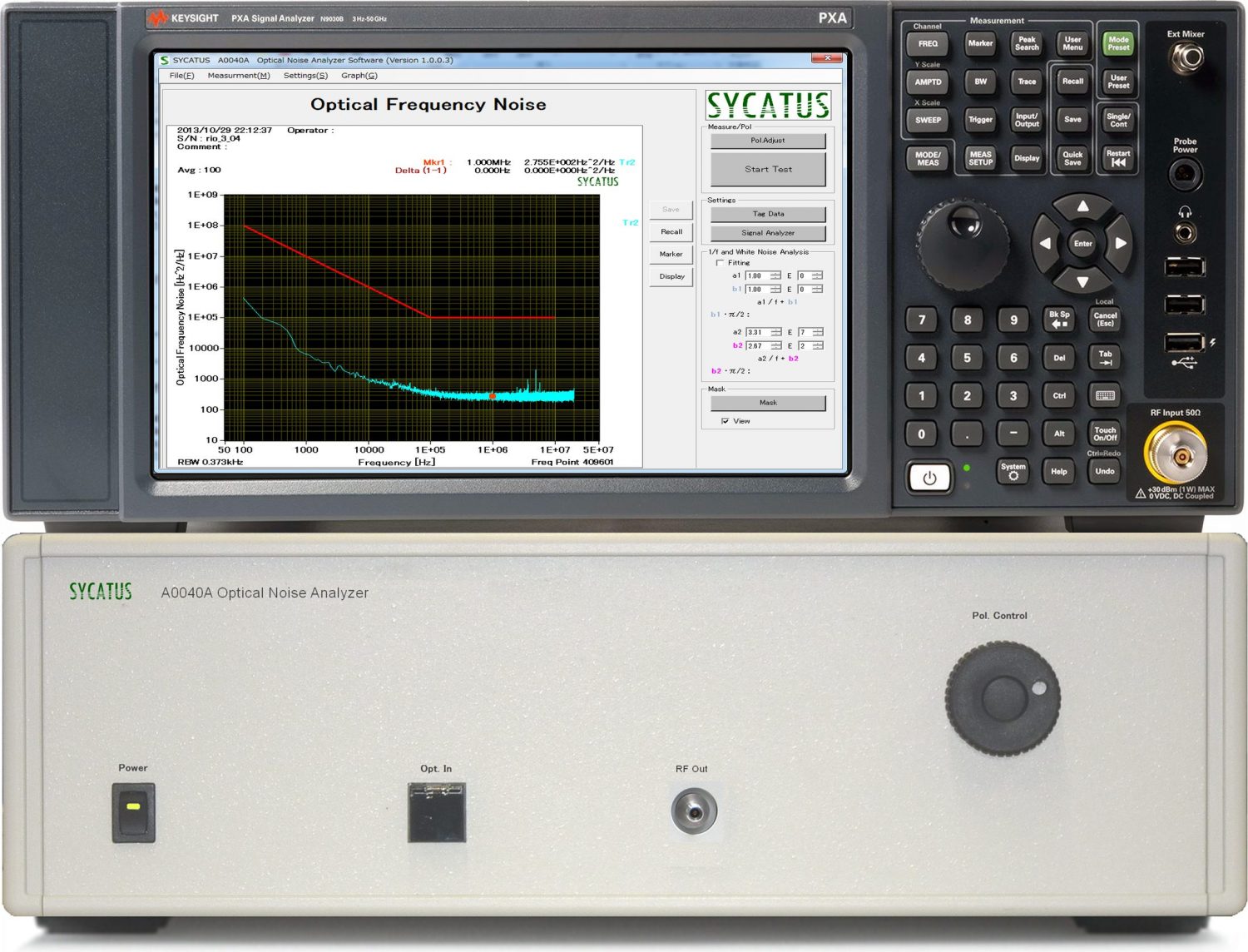
The A0040A Optical Noise Analyzer is the industry's first solution to evaluate laser line width as a power spectral density of light frequency noise.
It covers a wide wavelength range from O-band to L-band. Its extremely high resolution and sensitivity allow evaluation of Lorentz Linewidths as low as 0.002 Hz. In addition, the dynamic range exceeds 100 dB, enabling correct measurements even when a light frequency dither is used in the ITLA.
It analyzes 1/f noise, white noise, and Lorenz Linewidths of lasers required for digital coherent transmission systems. No pre-measurement adjustments are required, increasing measurement throughput and providing excellent accuracy and repeatability.
The ability to evaluate light frequency noise as a spectrum makes it ideal for evaluating light frequency noise in specific frequency bands, such as FMCW LiDAR.
In addition, the A0070A Optical Frequency Analyzer can also be integrated, enabling the evaluation of Light Frequency Modulation Characteristics and Light Frequency Noise Characteristics of lasers for FMCW LiDAR in a single unit.

The A0010A RIN measurement system uses a high-sensitivity, low-noise light receiver optimally designed for relative intensity noise (RIN) measurements and a high-performance X-Series signal analyzer from Keysight Technologies, Inc. The X-Series Signal Analyzers from Keysight Technologies, Inc. are used to evaluate the spectrum of relative intensity noise over a measurement bandwidth of 50 GHz, the world's largest.
Conclusion
FMCW (Frequency Modulated Continuous Wave) technology is extremely useful for LiDAR and radar and plays an important role in transportation, safety, and industry in general. Its high-precision measurements, velocity analysis, and real-time performance have led to innovations in many areas, including self-driving vehicles and aerospace.
In the future, FMCW technology will take a further leap forward as it becomes increasingly integrated with AI and nanotechnology. Its development will lead to the creation of new markets and a safer, more efficient society.
The future of FMCW technology is bright, and it is worth continuing to watch how future research and applications will unfold.
Feel free to contact us.
As a pioneer in measurement in the field of light communications and light sensing, SYCATUS has been providing integrated hardware and software systems for measurement for over 20 years.
We will continue to provide innovative light measurement technologies developed on the basis of expertise, uniqueness, and accuracy to the world.
We also provide expert advice on a wide range of light measurement questions and concerns regarding the installation of system equipment.
Our experts are available to help you solve your light measurement problems.

